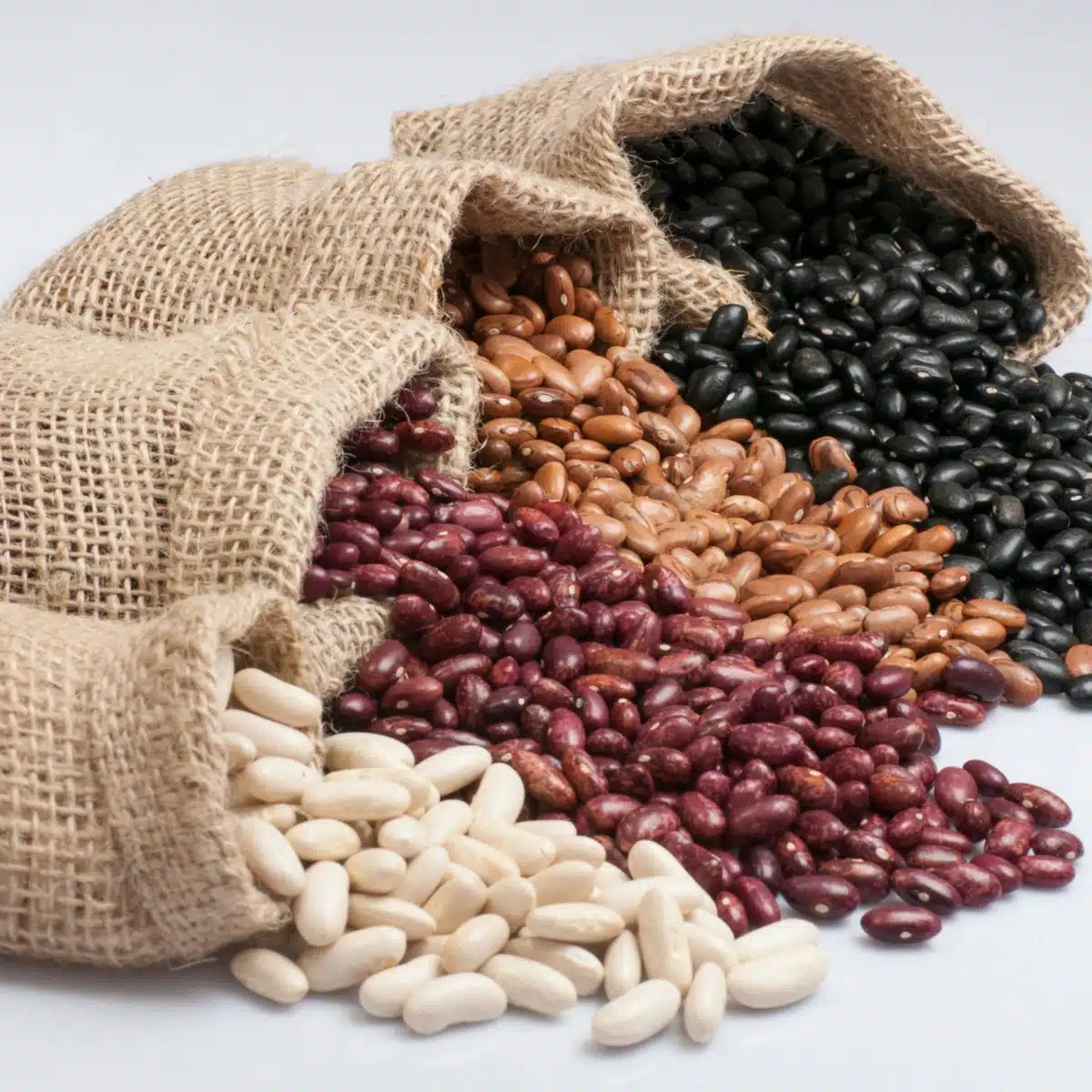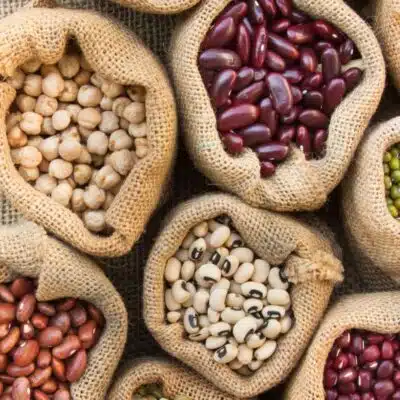The best beans for chili can easily elevate any of your favorite chili recipes into an extra flavorful and delicious meal! Whether you prefer a meaty, spicy, or even vegetarian chili, the choice of beans can make a huge difference! Here are the top varieties of beans for making the best batch of chili possible!
Best Types Of Beans For Making Chili
If you're a chili enthusiast like me, you've probably heard all about the debate as to whether or not beans belong in chili. Obviously, if you are reading this post, then it is safe to assume that you are pro-beans (which is the correct answer).
Believe it or not, grabbing any old can of beans that you might have in your pantry won't exactly yield the best batch of chili. Your choice of beans matters, as it will impact both the flavor and texture of the dish!

Jump to:
Best Varieties Of Beans For Chili
There are a ton of different types of beans out there, but these are easily the best options for chili! They can hold up to long cook times, won't become mushy, and have a great flavor.
1. Kidney Beans
Kidney beans are easily the most common and popular choice when it comes to making chili. They are hearty and rich and can be purchased in either light or dark varieties.
2. Pinto Beans
Pinto beans have a softer, creamier texture and are smaller in size than kidney beans. Due to their size, they do cook somewhat faster than other beans and can be added to your chili later in the cooking process if desired.
3. Black Beans
While black beans may be smaller than even pinto beans, they do have a firm texture that is great for holding their shape during the cooking process. Their rich and earthy flavor makes them a great contender for chili.
4. Great Northern Beans
Great Northern beans are a type of white bean that is commonly found in white chilis. They have a light, mild, and nutty flavor and easily take on all of the flavors in the chili.
5. Navy Beans
These small white beans are mild in flavor with a creamy texture. They are great at absorbing all of the flavors in the chili, making them a great option for people who don't want the beans to overpower the dish.
6. Chili Beans
You may have seen beans labeled as "chili beans" at the store before. These are actually pinto or kidney beans that are in a chili-like sauce (not necessarily beans that are meant for use in chili). You can add them straight to your chili if you are looking for some extra flavor.
Table 1: Best Beans For Chili At A Glance
| Best Beans for Chili | Why They're a Good Choice | How to Use Them |
|---|---|---|
| Kidney Beans | Kidney beans are the classic choice for chili due to their firm texture and hearty, robust flavor. They hold up well to the long cooking time usually associated with making chili. | Rinse and drain canned beans before adding them to your chili in the last 30 minutes of cooking. If using dried beans, soak and pre-cook them before adding. |
| Pinto Beans | Pinto beans are another popular choice for chili. When cooked, they have a creamy texture and a slightly sweet, nutty flavor that complements the spices typically used in chili. | Rinse and drain canned pinto beans before adding to chili. If using dried pinto beans, they should be soaked and then cooked until tender before adding. |
| Black Beans | Black beans are smaller than kidney and pinto beans but are firm, making them a good choice for chili. They have an earthy flavor that can provide a nice contrast to the spices in chili. | Rinse and drain canned black beans before adding them to your chili. If using dried beans, soak and cook them before adding. |
| Great Northern Beans | These beans are mild and versatile with a delicate flavor that won't overpower the other ingredients in chili. They have a firm texture that holds up well during cooking. | Rinse and drain canned Great Northern beans before adding them to your chili. If using dried beans, soak and cook them before adding. |
| Navy Beans | Navy beans are small, white beans that have a creamy texture and a mild flavor. They're a good choice if you want a bean that will absorb the flavors of your chili. | Rinse and drain canned navy beans before adding them to your chili. If using dried beans, they need to be soaked and cooked before adding. |
| Chili Beans | Chili beans are usually pinto or kidney beans that come canned in a flavorful sauce. They're a good choice if you're looking to add extra flavor to your chili. | Chili beans can be added straight from the can into your chili. Just be aware that the sauce will add extra flavor to your dish. |
Dried Beans vs Canned Beans For Chili
Another big consideration, in addition to choosing what type of beans you want, is deciding on whether you want to use dried or canned beans for your chili. Both are great options, so choose the one that works the best for you!
Dried Beans
Dried beans take much more preparation work than canned beans do. In fact, you need to sort through the beans, rinse them, and thoroughly soak them (typically overnight). Then, you can use them in any of your favorite chili recipes!
While this does require more effort, many people insist that dried beans have a better flavor and texture than canned beans do. Plus, you can easily control the sodium content.
Canned Beans
Canned beans are ideal for being quick, convenient, and essentially effortless. Simply open the can, drain and rinse the beans, and add them to your chili. *Make sure you check your recipe, as some prefer to keep the liquid from the canned beans in order to thicken the chili.
The downside to using canned beans is that they have a higher sodium content and are more likely to become mushy while cooking since they are already soft.
Tips For Choosing The Best Beans For Chili
- Texture: You'll want to choose a variety of beans that can handle simmering for a long period of time without breaking down and becoming mushy.
- Flavor: Different varieties of beans have different flavors. Some beans, like kidney and pinto beans, are bold in flavor, which pairs well with the hearty flavors of chili. Others, like Great Northern and navy beans, are much milder and will absorb the other flavors in the chili.
- Preparation: Choose whether you want to use canned beans or dried beans. Canned beans are super convenient and quick to use, while dried beans require soaking and cooking.
- Variety: You don't have to stick to just one choice! You can easily mix and match different varieties of beans.
- Availability: Some types of beans may be harder to find than others, depending on where you live. Choose beans that are readily available to you.
- Dietary considerations: You should always take dietary restrictions into consideration for you and your family. Some people may have difficulties with digesting specific kinds of beans, so opt for a variety that is more suitable.
>>>>See all of my recipes here<<<<
Now you know all of the best types of beans for making some flavorful and delicious homemade chili! Leave a comment down below and let me know which variety is your favorite!
🫘 Best Chili Recipes
- Chili Con Carne - A bold stovetop chili that features tasty kidney beans.
- Homemade Chili - This classic chili recipe is sure to become your favorite chili of all time.
- Venison Chili - A delicious twist on traditional chili by using venison instead of ground beef.
- Crockpot Chili - An effortless, hands-off chili that is made in your slow cooker.
- Texas Chili - The perfect chili recipe for anyone who doesn't want to add beans.
- Chili Mac - A combination of hearty, robust chili and rich macaroni and cheese for a tasty all-in-one meal.
Do you love a recipe you tried? Please leave a 5-star 🌟rating in the recipe card below and/or a review in the comments section further down the page.
Stay in touch with me through social media @ Pinterest, Facebook, Instagram, or Twitter! Subscribe to the newsletter today (no spam, I promise)! Don't forget to tag me when you try one of my recipes!
📖 Recipe Card
Best Beans For Chili: Homemade Chili (+Tips For Picking Your Flavors!)
Ingredients
- 4 tablespoon olive oil (extra virgin)
- 1 large white onion (diced, or use yellow onion)
- 1 large red bell pepper (diced, seeds removed)
- 1 large Anaheim pepper (seeds removed, diced)
- 2 large jalapeno peppers (finely diced, seeds removed)
- 1 tablespoon garlic (minced)
- 2 ½ lbs ground beef
- ¼ cup Worcestershire sauce
- 2 beef bouillon cubes
- 12 oz light beer (such as Coors, or use beef broth)
- 28 oz crushed tomatoes (San Marzano are recommended)
- 14.5 oz diced tomatoes (fire-roasted)
- 1 tablespoon tomato paste
- ½ cup white wine (or use more beef broth)
- 4 tablespoon chili seasoning (try my recipe or use your own)
- 1 tablespoon brown sugar
- 1 tablespoon chipotle pepper sauce
- ½ teaspoon each, salt & pepper (to taste)
- 32 oz dark red kidney beans (2 16-ounce cans, drained and rinsed)
- 16 oz chili beans (1 16-ounce can, drained and rinsed)
- 3 tablespoon cilantro (optional, chopped for garnish)
(Note: 2x or 3x only changes the ingredient list)
Instructions
- Place a large pot or Dutch oven over medium heat and add in the extra virgin olive oil. Once hot, add the onion, bell pepper, Anaheim pepper, jalapenos, and garlic. Cook and stir the veggies until they are tender.
- Meanwhile, in a separate skillet over medium-high heat, brown the ground beef for 5-7 minutes until no pink remains. Drain any excess fat.
- Into the browned meat, add the Worcestershire sauce, beef bouillon cubes, and beer. Continue to cook the meat mixture, using a wooden spoon to scrape the bottom of the pan as you stir for about 3 minutes (or until hot).
- Pour the beef mixture into the pot with the vegetables. Then, add the crushed tomatoes, diced tomatoes, tomato paste, wine, brown sugar, chipotle pepper sauce, salt, pepper, and chili seasoning mix. Stir to combine.
- Bring the mixture to a boil and then reduce the heat to medium-low. Cover the pot and allow it to simmer for about 90 minutes, stirring occasionally.
- Add in the kidney beans and chili beans, then continue to simmer for an additional 30 minutes.
- Garnish with cilantro, if desired, as well as any of your other favorite toppings. Serve immediately.
Notes
- For a chili recipe without any of the beer or wine, replace the alcohol with the same amount of additional beef broth. Instead, use 2 cups of beef broth and omit both the beer and wine.
- To store: Allow your chili to cool completely before transferring it to an airtight container and keeping it in the fridge for up to 4 days.
- To freeze: Freeze your chili in individual portions in a freezer-safe bag with the excess air squeezed out. It can be frozen for up to 3 months. Thaw overnight in the refrigerator.
- To reheat: Reheat your leftovers either in the microwave or in a pot on the stove.



Comments
No Comments